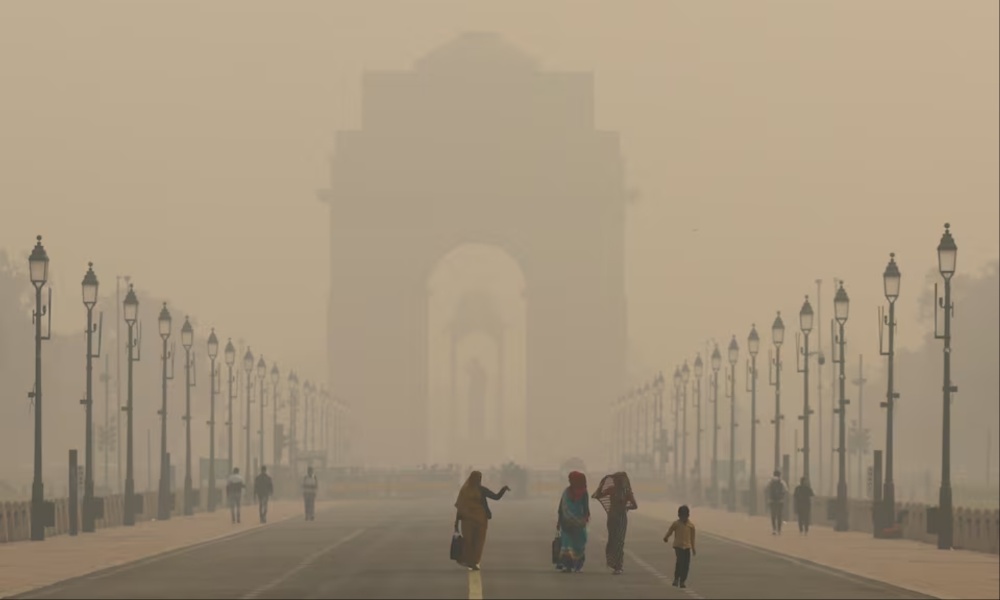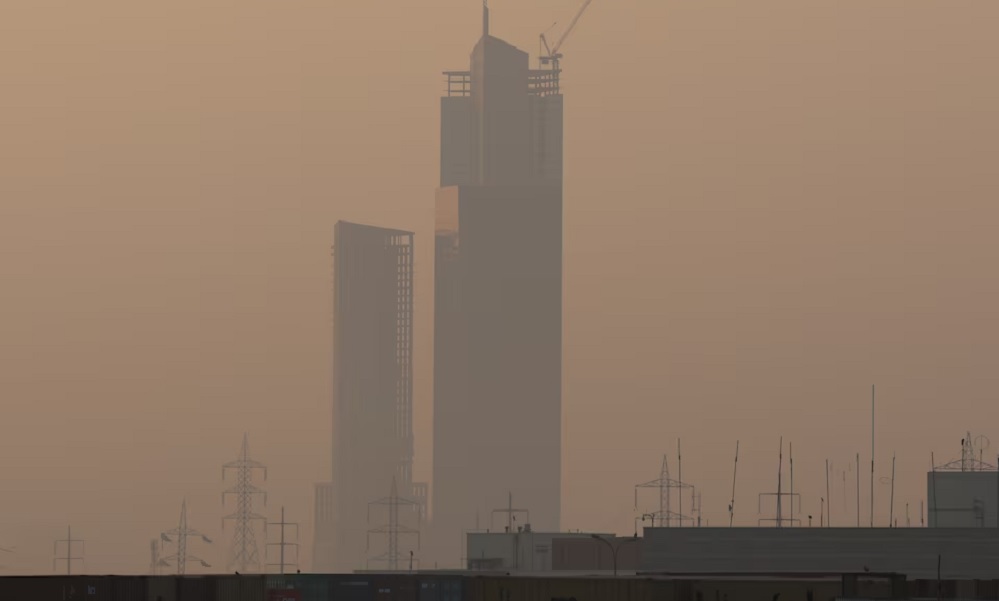Climate Change
Rescuers race to reach those trapped by floods in China’s Guangdong

WATCH: Rescuers on boats in China's flood-ravaged Guangdong province raced to evacuate trapped residents, carrying some elderly people by piggyback from their homes and deploying helicopters to save villagers caught in rural landslides.
The southern Chinese province has been battered by unusually heavy, sustained and widespread rainfall since Thursday, with powerful storms ushering in an earlier-than-normal start to the region's annual flooding season, Reuters reported.
Eleven people were missing in Guangdong by Monday morning, the state-owned Xinhua News Agency reported without giving further details.
Across the province, 53,741 people have been relocated, with 12,256 people being urgently resettled, Xinhua reported, citing the provincial government.
The cities of Shaoguan, Qingyuan, Zhaoqing and Jiangmen to the west and north of the provincial capital Guangzhou have been particularly hard hit.
In Qingyuan, houses and shops along the Bei River were submerged as the Pearl River tributary swelled, local media reported.
Aerial footage showed flood waters overwhelming a nearby town, leaving only roofs and treetops untouched.
Rescuers in Qingyuan tackled muddy waters, neck-high in some areas, to extract residents, including an elderly lady trapped in waist-deep water in an apartment building, videos on social media showed.
Other social media videos showed water gushing through roads and vehicles in disarray.
In Shaoguan, landslides trapped villagers who had to be rescued by helicopter while other rescuers traveled on foot to reach cut-off disaster sites, Reuters reported.
The Chinese military also stepped in to help clear roads.
The rains eased early on Monday, but some schools in the province were suspended.
Powerful thunderstorms are expected to return later in the week after a brief respite, marking an unusually early wet spell that is more typical in the months of May and June.
Climate Change
COP29 climate talks: What is needed for a deal by Friday’s deadline?
The talks, which began on Nov. 11, are due to end on Friday at 2pm but COP summits have a history of running long,

Marathon COP29 climate talks enter their final stretch on Wednesday when the Azerbaijani hosts are due to publish an update on negotiations so far as the summit seeks to agree a new goal on issues including climate finance.
The talks, which began on Nov. 11, are due to end on Friday afternoon but COP summits have a history of running long, Reuters reported.
Below is a breakdown of the known sticking points and what happens next:
DRAFT TEXTS
Officials spent the first week trying to agree to deals across a range of different issues including finance, carbon markets, the future of fossil fuels and efforts to mitigate the rise in global temperatures.
Now, the outstanding items have been handed over to ministers so they can use their political clout to try to get agreements across the line.
The next steps are about trying to whittle down draft texts containing a huge range of wording options into a final document that can be adopted by consensus at the end of the summit.
Draft texts will be published periodically by the Azerbaijani presidency as they zero in on an acceptable deal.
CLIMATE FINANCE GOAL
The primary aim of COP29 is to agree a new target for how much money should be provided to developing countries to help them adapt to climate-fuelled weather disasters and transition to cleaner energy systems.
A previous goal to provide $100 billion per year expires in 2025. The new goal needs to be $1 trillion annually by the end of the decade, according to experts.
The focus in the negotiating rooms has been on defining the structure of a new target, including what counts as climate finance and who needs to pay in. Only once that is agreed are parties expected to start talking about the size of the target.
Issues to iron out include whether countries such as China should be counted among the richer core donors, and the degree to which countries should provide finance in the form of grants or loans.
A text has been scheduled for publication on Wednesday evening.
FOSSIL FUELS
Countries have so far struggled to agree on the right way to follow up on a deal at last year's summit to transition from fossil fuels.
European states want to see that commitment referenced throughout any deal at Baku to reinforce the importance of following through with firm action. Others, including the Arab Group of states, argue it does not need to be.
If past COPs are anything to go by, the moment any deal text is published, delegates will be searching for the phrase "fossil fuels" to see if there is any sign of backsliding.
CARBON MARKETS
Talks in Baku began with an early deal on some of the quality standards that would govern a global market for carbon credits, but there is still much to be agreed on, including how to track trades and disclosure rules.
If fully agreed, market watchers expect a U.N.-backed global market could fund billions of dollars of projects that reduce greenhouse gas emissions from projects such as reforestation.
Scrutiny of the details is intense amid concern that without watertight regulation carbon credits may not deliver the benefits they claim.
FINAL HOURS
COPs rarely finish on time. COP28 in Dubai closed almost a full day after the initial deadline; COP27 in Egypt overran by around 36 hours.
In the final hours, delegations consult intensively in private with the presidency on the proposed deal, often through the night, in search of something that can be adopted by consensus.
Once finalised, every country is called to the main hall to begin an hours-long process of formal approval.
Climate Change
Toxic smog persists over India’s north; Delhi pollution remains severe
India battles air pollution every winter as cold, heavy air traps dust, emissions, and smoke from farm fires started illegally in the adjoining, farming states of Punjab and Haryana

Residents in India's northern states woke up to another day of poor air quality on Tuesday, as a layer of dense fog shrouded most of the region, and pollution in the capital Delhi remained severe.
India battles air pollution every winter as cold, heavy air traps dust, emissions, and smoke from farm fires started illegally in the adjoining, farming states of Punjab and Haryana.
The air quality index (AQI) touched a peak of 491 in Delhi on Monday, forcing the government to introduce restrictions on vehicle movement and construction activities, and schools to conduct classes online.
On Tuesday, Delhi's 24-hour air quality index (AQI) reading was at 488 on a scale of 500, India's Central Pollution Control Board (CPCB) said, and at least five stations in the capital reported an AQI of 500, Retuers reported.
CPCB defines an AQI reading of 0-50 as "good" and above 401 as "severe", which it says is a risk to healthy people and "seriously impacts" those with existing diseases.
Swiss group IQAir ranked New Delhi as the world's most polluted city with air quality at a "hazardous" 489, although that was a significant improvement from Monday's 1,081 reading.
Experts say the scores vary because of a difference in the scale countries adopt to convert pollutant concentrations into AQI, and so the same quantity of a specific pollutant may be translated as different AQI scores in different countries.
India's weather department said a shift in the fog layer towards the northern state of Uttar Pradesh had helped improve visibility over Delhi.
Visibility dropped to zero metres in Uttar Pradesh's capital Agra, which lies southeast of Delhi. The Taj Mahal, India's famed monument of love, has been obscured by toxic smog for nearly a week.
The strict measures to mitigate the impact of high pollution have hurt production at more than 3.4 million micro, small and medium enterprises in the nearby states of Punjab, Haryana and Delhi, local media reported.
Climate Change
Pakistan’s Punjab shuts construction and schools, and lockdown looms to fight smog

Pakistan's Punjab declared a health emergency due to toxic smog on Friday, banning construction, shutting schools for another week and moving universities online, with a three-day lockdown possible, the province's senior minister said on Friday.
Punjab battles toxic smog every winter as cold air traps dust, emissions, and smoke from illegal stubble burning on fields. Air quality has deteriorated drastically in recent weeks and the province's capital Lahore currently ranks as the world's most polluted city, says IQAir.
"A complete lockdown will be enforced on Friday, Saturday, and Sunday (next week) if the situation does not improve by Wednesday," said Punjab Senior Minister Marriyum Aurangzeb, addressing a press conference in Lahore.
Citizens were advised to stay indoors. Air Quality Index (AQI) readings in Lahore reached 637 at 3 p.m. (1000 GMT), according to Swiss group IQAir, significantly higher than levels recommended by the World Health Organization.
The government had ordered the closure of construction, brick kilns, and furnace-based plants in Lahore and the city of Multan, the minister said.
Punjab's government had last week ordered schools to close until Nov. 17, and on Friday the shift to online learning was extended for another week. Colleges and universities will also shut down, moving to virtual classes.
The eastern province has already banned entry to parks, zoos, playgrounds and other public spaces.
South Asia faces severe pollution each year due to trapped dust, emissions and stubble burning - the practice of setting fire to fields after the grain harvest.
Punjab has blamed this year's particularly high pollution levels partly on toxic air flowing from neighbouring India, where air quality has also reached hazardous levels.
India's capital of New Delhi, the world's most polluted capital city, banned all non-essential construction, moved younger children to virtual classrooms and asked residents to avoid using coal and wood from Friday to combat increasing air pollution.
New Delhi's air quality level reached 539 on Friday, according to live rankings by IQAir, the worst amongst global capitals.
-

 Sport5 days ago
Sport5 days agoFIFA unveils Innovative Club World Cup Trophy ahead of new tournament in 2025
-

 Regional5 days ago
Regional5 days agoIndia’s successful test of hypersonic missile puts it among elite group
-

 Latest News5 days ago
Latest News5 days agoTrump team compiling list of military officers responsible for US withdrawal from Afghanistan
-

 Latest News5 days ago
Latest News5 days agoCanada sent 19 failed asylum seekers back to Afghanistan last year
-

 Sport4 days ago
Sport4 days agoAbu Dhabi’s thrilling T10 tournament just days away
-

 World4 days ago
World4 days agoBiden allows Ukraine to use US arms to strike inside Russia
-

 Sport4 days ago
Sport4 days agoAfghanistan beat UAE by 169 runs in U19 tri-series
-

 Business5 days ago
Business5 days agoMullah Baradar inaugurates a blanket factory in Kabul
























